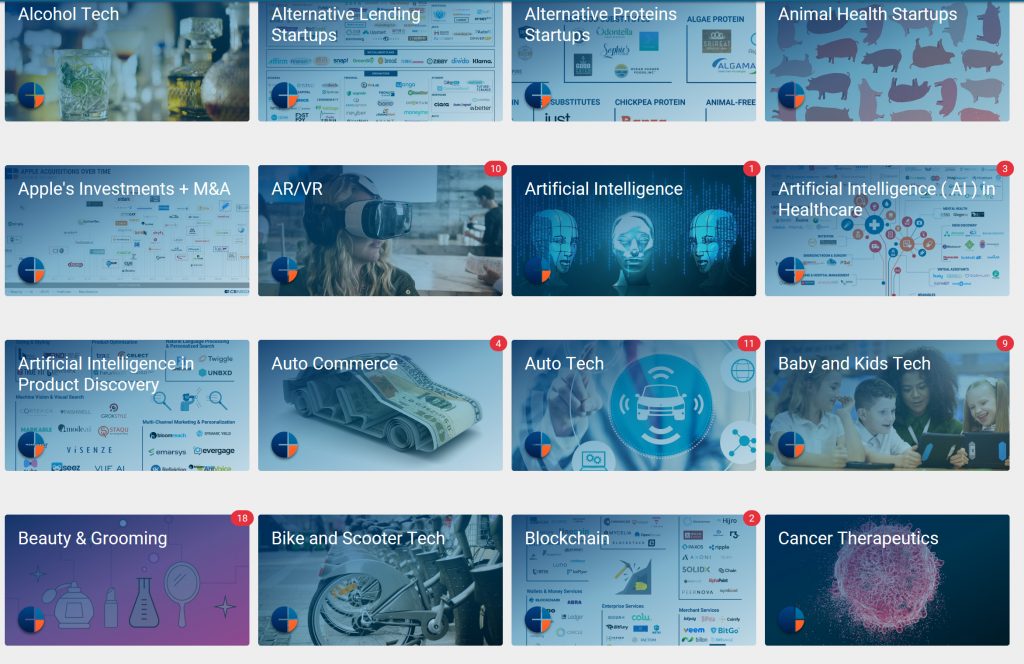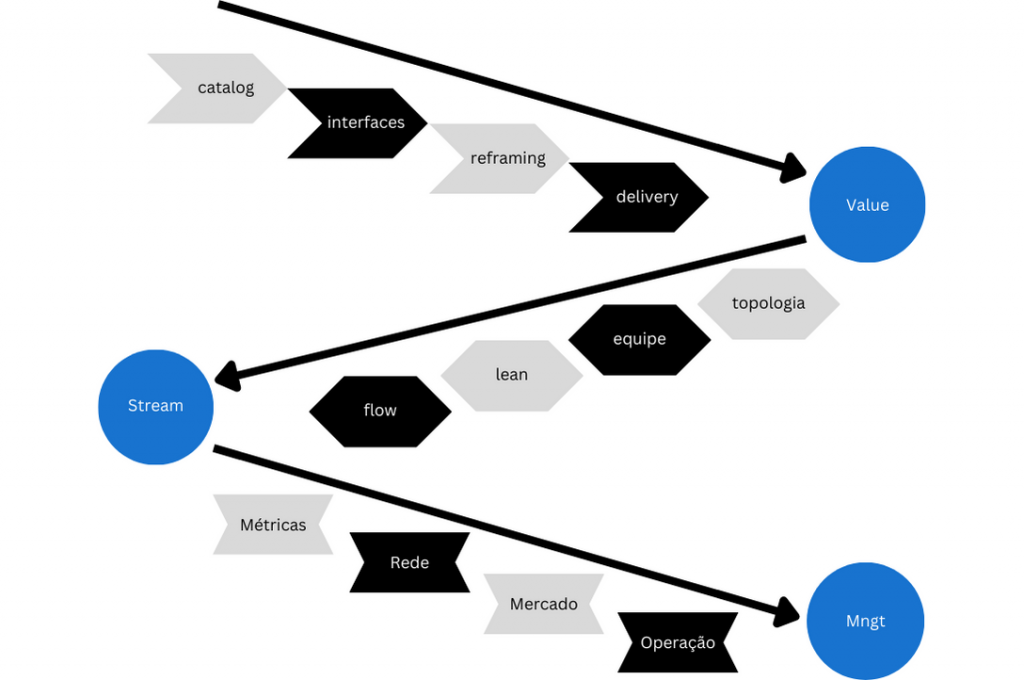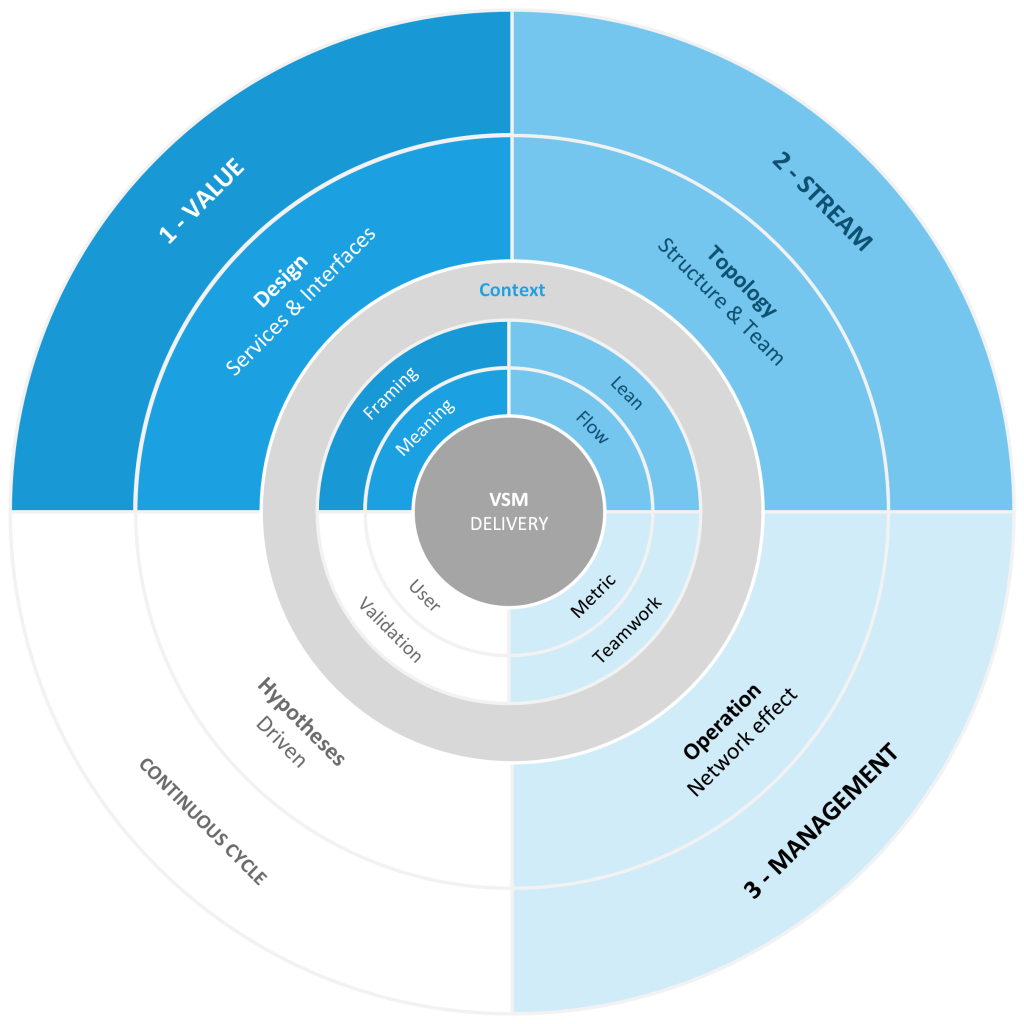A framework analysis for VSM – Value Stream Management requires a variety of perspectives about value meaning to the company context. We discuss here some of them that make part of this VSM framework.
First, design management as a process of coordinating and integrating design efforts within an organization. It involves establishing policies and procedures for design activities, setting design standards and guidelines, and ensuring that the design process aligns with the overall business strategy of the organization. It can be applied by many kinds of businesses.

Design management is concerned with both the creative aspects of design, such as aesthetics and functionality, as well as the more business-oriented aspects, such as cost, schedule, and risk management. It involves working with various stakeholders, such as designers, engineers, marketing professionals, and executives, to ensure that the design process is efficient, effective, and aligned with the goals of the organization.
Design management can be applied to a variety of fields, including product design, graphic design, web design, and architecture. It is an important aspect of project management and can help to ensure that design projects are completed on time, within budget, and to the desired level of quality.
All this aspects of design management are important to Value Management into organizations.
Making it real
Value management can be applied at various stages of a project or product’s lifecycle, from the early planning and conceptualization phase through to implementation and operation. It is typically used to identify and eliminate unnecessary or low-value elements of a project, streamline processes, and improve efficiency and effectiveness.
The value management is a process that aims to optimize the value of a product, service, or project by identifying and prioritizing the requirements of the stakeholders and then finding the most effective and efficient way to meet those requirements. It is a systematic approach that involves breaking down the overall project or product into its individual components, analyzing the functions and values of each component, and then finding ways to optimize the value of those components.
Value management can be applied to a wide range of projects and industries, including construction, engineering, manufacturing, and service delivery. It is a key aspect of project management and can help to ensure that resources are used effectively and that the final product or service meets the needs of the stakeholders in the most cost-effective way possible.
A value-driven strategy is a business approach that focuses on creating and delivering value to customers as the primary goal of the organization. It involves identifying the needs and preferences of customers, and then developing products, services, and experiences that meet those needs in a way that exceeds customer expectations and creates value for both the customer and the organization.
A value-driven strategy differs from other business strategies, such as cost-driven or differentiation-driven strategies, which focus on minimizing costs or offering unique products or services as the primary means of creating value. Instead, a value-driven strategy seeks to understand and meet the needs of customers in a way that is both valuable to them and financially sustainable for the organization.

To implement a value-driven strategy, an organization must be customer-centric and focused on continuously improving the customer experience. This requires a deep understanding of customer needs and preferences, as well as the ability to gather and analyze customer feedback and data. It also requires a culture of innovation and a willingness to constantly adapt and improve the organization’s offerings to meet changing customer needs.

Hypotheses Validation
The user experiment and the business hypotheses need to be validate, understand the feasibility of it. Front-load design is a design approach that involves completing as much of the design work as possible at the beginning of a project. This includes identifying and defining the requirements for the project, researching and selecting the appropriate technologies and materials, and developing detailed design plans and specifications.
The goal of front-load design is to reduce the risk of errors or changes later in the development process by doing as much of the design work up front as possible. By completing a significant portion of the design work at the beginning of a project, designers can identify and address potential issues early on, which can help to reduce the risk of delays or cost overruns later in the project.
Front-load design is typically used in projects where the consequences of errors or changes later in the process would be significant, such as in the construction of large infrastructure projects or the development of complex systems. It can also be used in projects where the cost of making changes later in the process would be high, such as in the development of custom manufacturing equipment.
The implementation plan requires a road mapping delivery to reach out the value stream designed before. To make it real is necessary have a PI – Program Increment and a transition phase to have the value delivered. Then componentization is crucial to make it feasible and interfaces are necessary. Similar in the software industry we have the concept of microservices.
Microservices are a software architecture style in which a single application is built as a suite of small, independent services. Each service is designed to perform a specific function and communicates with other services through well-defined APIs (Application Programming Interfaces).
An API is a set of programming instructions and standards for accessing a web-based software application or web tool. It specifies how software components should interact and enables communication between different systems. In the context of microservices, each service in the application exposes an API that allows it to be called by other services or by external clients.
Using a microservices architecture with APIs allows for greater flexibility and scalability in the development and deployment of an application. It also allows for more efficient and granular updates and maintenance of the application, as each service can be updated or modified independently of the others.
Microservices APIs are typically built using REST (Representational State Transfer) or GraphQL, which are popular standards for building web APIs. REST APIs use HTTP (Hypertext Transfer Protocol) as the communication protocol and use a set of standard HTTP verbs (such as GET, POST, PUT, and DELETE) to perform actions on resources. GraphQL APIs use a single endpoint and allow the client to specify exactly which data it needs, rather than the server determining the data to be returned.
A service interface, also known as a service contract, is a set of definitions and specifications that describe the behaviors and capabilities of a service. It defines the inputs, outputs, and operations of the service, and specifies the rules and constraints under which the service can be used.
A service interface is an important aspect of software design and development, as it defines the boundaries and capabilities of a service and allows it to be used in a consistent and predictable manner. It acts as a contract between the service provider and the service consumer, specifying the terms under which the service can be accessed and used.
Service interfaces are typically defined using a specific syntax or language, such as WSDL (Web Services Description Language) for web services or IDL (Interface Definition Language) for CORBA (Common Object Request Broker Architecture) services. They are used to document the service and provide a reference for developers who want to use the service in their own applications.
In the context of microservices, a service interface is the API (Application Programming Interface) that is exposed by each service in the application. It defines the methods and parameters that can be used to interact with the service and enables communication between the service and other components of the application. Of course that a systemic view is important to overall decisions.
Systems engineering design is the process of designing and developing complex systems that meet the needs of stakeholders and users. It involves the integration of multiple components, including hardware, software, and human factors, to create a system that is functional, reliable, and cost-effective.
Systems engineering design involves a systematic and holistic approach to problem-solving that takes into account the interactions and dependencies between different components of the system. It involves identifying the requirements and constraints of the system, developing and evaluating design alternatives, and integrating and testing the various components of the system.
Systems engineering design can be applied to a wide range of fields, including aerospace, defense, transportation, telecommunications, and manufacturing. It is an interdisciplinary field that draws on concepts and tools from various fields, including engineering, computer science, and management.
The goal of systems engineering design is to create systems that are efficient, effective, and capable of meeting the needs of the users and stakeholders. It requires a deep understanding of the technical and operational aspects of the system, as well as the ability to manage the complexity of the development process and ensure that the final product meets the desired performance and reliability standards.
A product interface is the point of interaction between a product and its users. It is the way in which a user interacts with the product, whether it is through buttons, screens, or other types of input/output devices.
The design of a product interface is an important aspect of product development, as it affects the usability and user experience of the product. A well-designed product interface should be intuitive, easy to use, and efficient, and should minimize the learning curve for the user.
There are several types of product interfaces, including graphical user interfaces (GUIs), command-line interfaces (CLIs), and web-based interfaces. The type of interface that is used will depend on the nature of the product and the needs and preferences of the users.
In addition to the user interface, a product may also have other types of interfaces, such as hardware interfaces that connect the product to other devices, or software interfaces that allow the product to communicate with other software applications. The design of these interfaces is also an important aspect of product development, as it affects the compatibility and functionality of the product.
Emergente technologies should be consider in any solution approach. The digital services as strategic planning.
A digital-first approach is a business strategy that prioritizes the use of digital technologies and channels in the delivery of products, services, and experiences to customers. It involves designing and delivering products and services with the assumption that they will be primarily accessed and consumed online, and that the digital experience will be the primary point of interaction with the customer.
A digital-first approach is based on the idea that the increasing prevalence of digital technologies has changed the way that customers interact with businesses and that it is important for businesses to adapt to these changes in order to remain competitive. It involves a focus on creating seamless, convenient, and personalized digital experiences for customers, and on leveraging data and analytics to better understand and meet the needs of customers.
A digital-first approach requires an organization to have a strong digital presence and to be able to deliver high-quality digital products and services. It also requires a focus on continuous innovation and the ability to adapt to changing customer needs and preferences. Adopting a digital-first approach can help businesses to improve customer satisfaction, increase efficiency, and gain a competitive advantage in their market.
All this is pre-requirement to value stream design.
Value stream management is a process that involves identifying, analyzing, and optimizing the flow of activities and information that are required to create and deliver value to customers. It involves mapping the entire process from start to finish, including all of the steps, activities, and resources that are involved in creating and delivering a product or service to a customer.
The goal of value stream management is to identify and eliminate waste and inefficiencies in the value stream, and to optimize the flow of value to the customer. This can be achieved through a variety of means, such as reducing cycle times, automating processes, and standardizing work.
Value stream management is an important aspect of lean and agile methodologies, which focus on continuous improvement and the elimination of waste in order to create value for customers. It can be applied to a wide range of industries and is often used in manufacturing, healthcare, and software development.
Implementing value stream management requires the development of a clear understanding of the value stream, the identification of key performance indicators (KPIs) to measure progress, and the implementation of continuous improvement efforts to optimize the flow of value to the customer.
Adapting the teamwork organizational structure to meet changing needs and circumstances can be achieved through the following steps:
- Assess current structure: Evaluate the current organizational structure to identify areas where changes may be necessary. Consider factors such as team composition, roles and responsibilities, and communication and collaboration processes.
- Identify the need for change: Determine why changes to the organizational structure are needed. This may be due to changes in the business environment, shifting priorities, or changes in the needs and expectations of stakeholders.
- Develop a new structure: Based on the assessment and identification of the need for change, develop a new organizational structure that better aligns with the organization’s goals and objectives. Consider factors such as team size, composition, and location, as well as communication and collaboration processes.
- Communicate the change: Communicate the new organizational structure to all relevant stakeholders, including employees, customers, partners, and shareholders. Ensure that everyone understands the reasons for the change and what the new structure means for them.
- Implement the change: Implement the new organizational structure, making any necessary changes to roles, responsibilities, processes, and systems. Ensure that everyone understands their new roles and responsibilities, and that any necessary training is provided.
- Monitor and evaluate: Regularly monitor and evaluate the impact of the new organizational structure on the organization’s performance, customer satisfaction, and employee engagement. Make adjustments as necessary to ensure that the structure continues to meet the organization’s goals and objectives.
By adapting the organizational structure to meet changing needs and circumstances, organizations can ensure that they remain competitive, efficient, and effective in delivering value to customers and stakeholders.

No responses yet